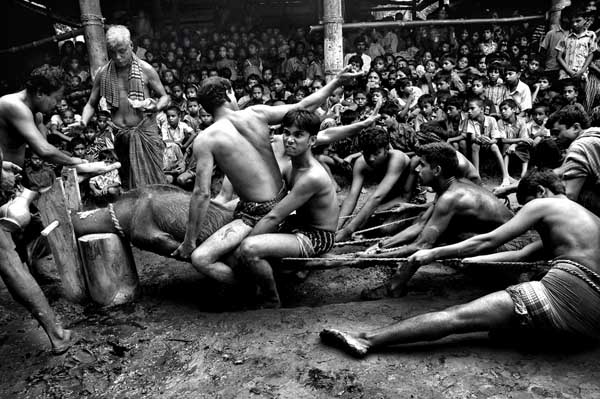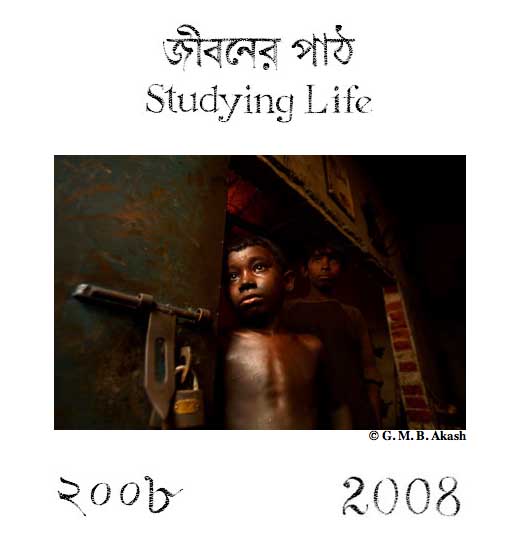![]()
![]()
10th year of Pathshala
Video on Pathshala by Brian Palmer. Commissioned by Pullitzer Foundation:
 Boli. Goat being sacrificed at Hindu religious ceremony. ? Saikat Mojumder.
Boli. Goat being sacrificed at Hindu religious ceremony. ? Saikat Mojumder.
Rashid Talukder had been unwell and had excused himself. The other board members Afzal Chowdhury, Mahfuz Anam, Nawazesh Ahmed and I had pored over the crude portfolios. Much of the work was raw, but there was freshness and a vibrancy that touched us all. This new school would take risks. Ideas would be given a chance.
The students have emulated that principal characteristic of Pathshala. Reaching for the impossible has become the norm. Pushing the school and themselves to the limit has been their mode of practice. Dreaming, a way of life.
On the day of the first workshop, with World Press Photo in 1998, a hastily flung white cloth had covered up the bricks being used for the unfinished construction of the computer lab. On its tenth year, the school boasts achievements by students that is the envy of schools worldwide. The early partnerships, with World Press Photo Foundation, The British Council, Panos Institute, The Thomson Foundation and Free Voice (formerly CAF) have all played an important role, but the new liaisons, with the University of Liberal Arts in Bangladesh, and the upcoming regional masters programme between universities in Bangladesh, China, Indonesia, Nepal, Norway and Pakistan are paving the way for a school that has matured beyond its years.
The academic exchanges with Oslo University College in Norway and Edith Cowan University in Australia provide Pathshala students an opportunity to share experiences with students of very different backgrounds. The long-term partnerships with Sunderland University, Bolton University and the Danish School of Journalism, offer educational opportunities for students with other world class institutions. The internship opportunities at Drik, Chobi Mela and Drik News offer on-the-job training that is invaluable in professional life. The regular participation in international festivals and workshops provide a world-view essential to becoming established in the global marketplace. And then there is the acid test. Emerging students are in demand, and ever since Pathshala started, all students who have graduated are gainfully employed. Some are already at the very top of their profession.
But the goal of Pathshala is far more than teaching photography. It is about using the language of images to bring about social change. It is about nurturing minds and encouraging critical thinking. It is about responsible citizenship. In a land where textual literacy is low, it is about reaching out where words have failed. In a society where sleek advertising images construct our sense of values, studying at Pathshala is about challenging cultures of dominance.
Curating an exhibition of so diverse a group is always difficult. One wants to be inclusive but selective. Demonstrate trends, but value differences. Nurture new talent, but recognise excellence. Choose favorites but not be partisan. The greater importance given to some artists has as much to do with what needs to be said now as it has to do with the calibre of their work. Pathshala cannot be an academic island untouched by local realities. While recognising the merit of those producing quality work, space has also to be given to voices that need to be heard now. These are images of ‘Now’ being articulated.
Shahidul Alam
A True Pathshala
The word Pathshala, a traditional Sanskrit word for a seat of learning, was generally associated with the shade of mango trees in open fields. There were no walls, no classrooms, no formal structures, but children gathered to listen to wise folk. It was wisdom being shared.
Having decided that the language of images was the tool to use to challenge western hegemony and to address social inequality within the country, Drik had begun to put in place the building blocks to make it happen. The agency was serving people already in the trade, but opportunities for learning had to be created. There wasn?t a single credible organization for higher education in photography in the region. One had to be built. Taking advantage of a World Press Photo seminar on 18th December 1998, the school was setup. A single classroom was all that was available. The visiting tutors Chris Boot (formerly with Magnum, then with Phaidon) and Reza Deghati (National Geographic) conducted the workshops. I continued as a lone tutor. Kirsten Claire an English photographer whom a friend had recommended, came over soon afterwards and stayed for a year. We paid her a local salary, the best we could afford. The two of us formed the faculty.
A stream of tutors, all friends willing to be arm twisted, came at regular intervals. For some we provided air fare and modest accommodation. Some came at their own cost. Some slept on our floor. Some, like Ian Berry, who had come over on an assignment, were simply roped in. The students, most new to the craft, didn?t know they were rubbing shoulders with the greatest names in photography. And it was an impressive list of names. Abbas, David Wells, Daniel Meadows, John Vink, Ian Berry, Ingrid Pollard, Martin Parr, Morten Krogvold, Pablo Bartholomew, Pedro Meyer, Raghu Rai, Reza Deghati, Robert Pledge, Steven Mayes, Tim Hetherington, Trent Parke and many others had spent quality time with Bangladeshi photographers. Some had come even before Pathshala started. Some, like Robert Pledge, Reza Deghati, Abbas, David Wells, Morten Krogvold and Raghu Rai, were repeat visitors. Few demanded payment; none flaunted their superstar stautus, one even made an anonymous donation. They all wanted to be part of a very exciting journey. One or two wanted to be on the faculty to embellish their CVs, but they all gave generously, and this organization has been built on their labour of love.
Lazy at first and unaware of how special the environment was, the students soon became infected by the passion of their marvelous tutors. They studied photography, economics, statistics, environmental studies, visual anthropology. They were in a true Pathshala, studying life. And it showed. Despite the limited resources of the school, we maintained one goal we had set for ourselves at the outset. Every emerging student was gainfully employed. The trend has continued since 1998. They got selected for the prestigious Joop Schwart Masterclass. They won awards like the Mother Jones, World Press, the National Geographic All Roads and a host of other prestigious awards. Time Magazine, Newsweek, New York Times and other leading publications began to hire them, and the reputation spread. Soon students and interns from other countries began to come in. Most were from neighbouring countries, but some from far flung places like Norway, the USA and Australia wanted to join.
The number of regular tutors has grown from the original two to eleven. Eight are former students. The tutor to student ratio remains very high. DrikNews, a news agency which gives emphasis to rural reporting, hires former Pathshala students for its their core staff. The staff photographers and picture editors of most major newspapers in Bangladesh are from Pathshala. Some are also working in television stations and other broadcast media. And Pathshala continues to defy gravity. A school of photography in one of the most economically impoverished nations and with no external support, continues to produce some of the finest emerging photographers.
Shahidul Alam
The school of photography Pathshala, is entering its tenth year. Greetings to all students, teachers and well-wishers who have journeyed with us over the last nine years. An exhibition “Studying Life” featuring the work of Pathshala students and alumni will mark the beginning of our celebrations.
Pioneer playright and theatre person Atiqul Huque Chowdhury will inaugurate the exhibition on 1st February 2008 at 5:00 pm at Drik Gallery.
The exhibition will continue till 15th February 2008 and will be open to all from 3:00 pm till 8:00 pm.
You are invited.
Inauguration date: 1 February 2008
Time: 5:00 pm
Exhibition duration: 1 February – 15 February 2008 (3-8 pm. every day)
Venue: Drik Gallery, House 58, Road 15A (new), Dhanmondi Residential Area, Dhaka.
Programme:
1 February 2008
5:00 pm, Drik Gallery
Opening of photography exhibition “Studying Life”
2 February 2008
Pathshala Campus (16 Sukrabad, Panthapath)
3:00 pm: Certificate Distribution
3:45 pm: Discussion on Photography
4:30 pm: Portfolio Presentation
5:15 pm: Film Show
3 February 2008
Pathshala Campus (16 Sukrabad, Panthapath)
2:30 pm: Portfolio Presentation
6:30 pm: Songs by Prachyanat
8:30 pm: Dinner
Selected photographs from the exhibition can be seen in the Drik 2008 Calendar:

Submissions are invited for Chobi Mela V. The theme is “Freedom”. The online submission form will be available at www.chobimela.org from the 7th February 2008.
3 thoughts on “Studying Life”
Leave a Reply
You must be logged in to post a comment.

Wish Drik all glory and Chhobi Mela all success. This is to
celebrate one decade of grit, of reaching for the stars when sometimes Drik and Pathshala were unsure of even the ground they stood on. Pathshala has lived up to its name –
multi-faceted drive for excellence, fostering of socially committed imagination, quest of grandeur in the grimy byways of life. It has thumbed at virgin horizons. It has extended its outreach. It has proved beauty and bread are viable together.
May it grow from success to splendour.
Even though I am not a vegetarian, I am horrified by looking at the picture of ?Boli? being performed. This type of animal cruelty should be banned. These people are unaware of what they are doing in the name of pleasing God, who is probably as horrified as I am. Blame falls on the education system, which should have taught tolerance and respect for other living beings around us. This is a total disrespect for another living being. I see equally horrified images when EID arrives every year. These rituals are performed only to satisfy their own psyches, definitely not God.
good yaa